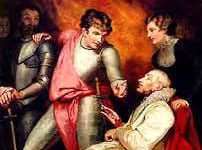Shakespearean Characters
Shakespearean Characters
Shakespearean Characters
Introduction
William Shakespeare, the renowned playwright of the Elizabethan era, created an expansive and diverse array of characters that have left an indelible mark on literature. From tragic heroes to comedic foils, Shakespeare’s characters reflect the complexities of human nature, offering profound insights into the human experience.
Tragic Heroes
Hamlet
Introduction: Prince Hamlet, the protagonist of “Hamlet,” is a classic Shakespearean tragic hero.
Characteristics:
Tragic Flaw: Hamlet’s indecision and overthinking become his tragic flaw.
Internal Conflict: His internal struggles and philosophical musings add depth to his character.
Downfall: Hamlet’s journey ends tragically, leading to his demise and the unraveling of the Danish court.
Macbeth
Introduction: The titular character of “Macbeth” is a tragic figure whose ambition becomes his undoing.
Characteristics:
Ambition: Macbeth’s unchecked ambition leads to moral decay and a descent into madness.
Guilt: The haunting guilt from his deeds contributes to his tragic downfall.
Fate and Free Will: The interplay of fate and free will shapes Macbeth’s tragic trajectory.
Comedic Figures
Bottom (A Midsummer Night’s Dream)
Introduction: Bottom, a weaver in “A Midsummer Night’s Dream,” exemplifies Shakespearean comedic characters.
Characteristics:
Comic Relief: Bottom provides comic relief with his literal and metaphorical transformations.
Hubris: His comically inflated ego contrasts with his actual social status.
Interaction with Fairies: Bottom’s interactions with the fairy world add whimsy to the comedic subplot.
Sir Toby Belch (Twelfth Night)
Introduction: Sir Toby Belch in “Twelfth Night” embodies the archetype of the festive and jolly character.
Characteristics:
Merry-Making: Sir Toby is associated with revelry, drinking, and a carefree attitude.
Contrast with Other Characters: His contrast with the more serious characters enhances the comedic elements of the play.
Role in Subplots: Sir Toby’s antics contribute to the humorous subplots and misunderstandings.
Complex Women
Lady Macbeth
Introduction: Lady Macbeth in “Macbeth” defies traditional gender roles and presents a complex female character.
Characteristics:
Ambition and Manipulation: Lady Macbeth’s ambition and manipulation drive the plot.
Psychological Strain: Her descent into guilt and madness reflects the psychological toll of her actions.
Symbolic Imagery: Lady Macbeth’s sleepwalking scene and the motif of blood underscore her internal turmoil.
Beatrice (Much Ado About Nothing)
Introduction: Beatrice is a witty and independent character in “Much Ado About Nothing.”
Characteristics:
Sharp Wit: Beatrice’s sharp wit and banter with Benedick add humor to the play.
Independence: Her refusal to conform to societal expectations of women showcases her independence.
Emotional Vulnerability: Despite her strong exterior, Beatrice reveals emotional vulnerability, adding depth to her character.
Villains and Antagonists
Iago (Othello)
Introduction: Iago in “Othello” is one of Shakespeare’s most sinister villains.
Characteristics:
Manipulation: Iago’s manipulation of Othello and others drives the tragic events.
Motivation: His motives, often attributed to jealousy and resentment, highlight the complexity of villainy.
Lack of Clear Motivation: Iago’s lack of a clear, understandable motive adds to the unsettling nature of his character.
Shylock (The Merchant of Venice)
Introduction: Shylock, the Jewish moneylender in “The Merchant of Venice,” is a complex antagonist.
Characteristics:
Stereotype and Humanity: Shylock challenges stereotypes but is also depicted with humanity and depth.
Revenge and Mercy: His demand for a pound of Antonio’s flesh reflects themes of revenge and mercy.
Tragic Element: Shylock’s ultimate downfall adds a tragic dimension to his character.
Conclusion
In conclusion, Shakespearean characters form a rich tapestry that captures the breadth and depth of human experience. From tragic heroes to comedic figures, complex women to villains, Shakespeare’s characters resonate across centuries, offering timeless insights into the complexities of the human psyche and the varied facets of human nature. 0 0 0.
Shakespearean Characters, Shakespearean Characters
N.B. The article ‘Shakespearean Characters’ originally belongs to the book entitled ‘Essays on Shakespeare and His Time‘ by Menonim Menonimus.
You May Like:
- Reviews on Shakespeare’s Works
- Shakespeare’s Sister-An Analytical Study
Additional Searches:
- Shakespeare’s Legacy Shaping Modern Literature
- Shakespeare’s 25 Greatest Characters
- Shakespeare Characters …










